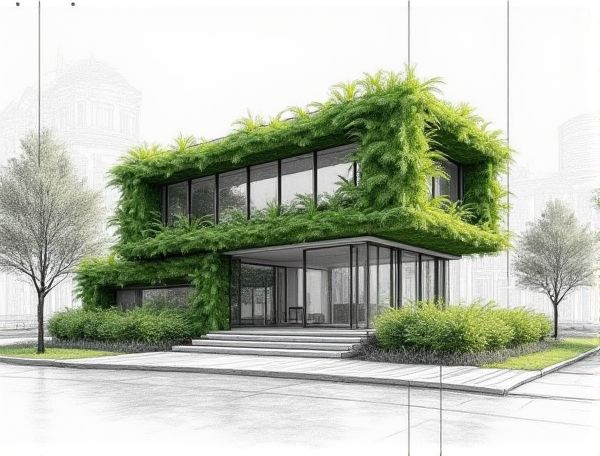
Photo illustration: Biomimetic home design with integrated living green walls
Biomimetic home design incorporates natural principles to create sustainable and efficient living spaces, with integrated living green walls enhancing air quality and aesthetic appeal while reducing energy consumption. Discover how incorporating these innovative features can transform Your home environment by reading more in the article.
Introduction to Biomimetic Home Design
Biomimetic home design draws inspiration from nature's efficient systems and structures to create sustainable, energy-efficient living spaces. This approach integrates organic forms, natural materials, and adaptive technologies to enhance comfort and reduce environmental impact. Utilizing biomimicry principles, designers optimize resource use while promoting harmony between built environments and ecosystems.
Principles of Biomimicry in Architecture
Incorporating principles of biomimicry in architecture enhances sustainability by emulating natural processes and ecosystems, optimizing energy efficiency and material usage. Your home design benefits from innovative solutions inspired by nature's patterns, improving environmental harmony and resilience.
Benefits of Integrated Living Green Walls
Integrated living green walls improve indoor air quality by filtering pollutants and increasing oxygen levels, enhancing your home's overall health environment. These vertical gardens also provide natural insulation, reducing energy costs while adding aesthetic appeal and promoting mental well-being.
Natural Inspiration for Green Wall Systems
Natural inspiration for green wall systems transforms your living space by integrating thriving plant life that mimics outdoor environments. These systems leverage native flora and biomimicry principles to enhance air quality, regulate indoor temperature, and promote well-being. Embracing such designs fosters a seamless connection between nature and architecture, creating sustainable, visually appealing interiors.
Key Biomimetic Features in Home Environments
Key biomimetic features in home environments include natural ventilation systems that mimic the cooling effects of termite mounds and the use of self-cleaning surfaces inspired by lotus leaves, enhancing energy efficiency and maintenance. Incorporating daylight-redirecting materials, similar to the structure of butterfly wings, optimizes natural light distribution, reducing reliance on artificial lighting. Your home will benefit from adaptive insulation techniques modeled after animal fur, maintaining comfortable indoor temperatures year-round.
Air Quality Enhancement through Plant Integration
Integrating indoor plants into your home design significantly improves air quality by naturally filtering airborne toxins and increasing oxygen levels. Species such as spider plants, peace lilies, and snake plants are proven to reduce pollutants like formaldehyde, benzene, and carbon monoxide. You can enhance your living space's health and aesthetic appeal simultaneously through strategic plant placement.
Sustainable Materials for Living Green Walls
Living green walls incorporate sustainable materials like recycled metal frames and biodegradable felt to support healthy plant growth while reducing environmental impact. Utilizing native plant species and organic soil substrates enhances air purification and energy efficiency within indoor and outdoor spaces. These eco-friendly components contribute to improved biodiversity, lower carbon footprints, and long-lasting structural integrity in home designs.
Designing Energy-Efficient Biomimetic Homes
Designing energy-efficient biomimetic homes involves integrating natural ecosystem principles to optimize thermal regulation, water conservation, and energy use. Incorporating biomimetic features such as passive solar heating, natural ventilation inspired by termite mounds, and adaptive shading systems enhances sustainability and reduces carbon footprints. Advanced materials mimicking natural insulation and self-healing properties further improve durability and energy performance in residential architecture.
Maintenance and Longevity of Green Wall Installations
Green wall installations require regular maintenance, including irrigation system checks, pruning, and pest control, to ensure plant health and structural integrity. Using drought-resistant and low-maintenance plant species enhances the longevity of green walls by reducing water consumption and minimizing care needs. Proper design with durable materials and integrated drainage systems prevents water damage and supports the green wall's sustainable lifespan.
Future Trends in Biomimetic Home Design
Biomimetic home design integrates nature-inspired solutions to enhance energy efficiency, indoor air quality, and structural resilience. Innovations such as self-healing materials, adaptive climate control systems, and natural ventilation models mimic biological processes to reduce your home's environmental impact. Smart systems powered by AI optimize resource use and create healthier, more sustainable living spaces aligned with future eco-conscious trends.
 homedesy.com
homedesy.com